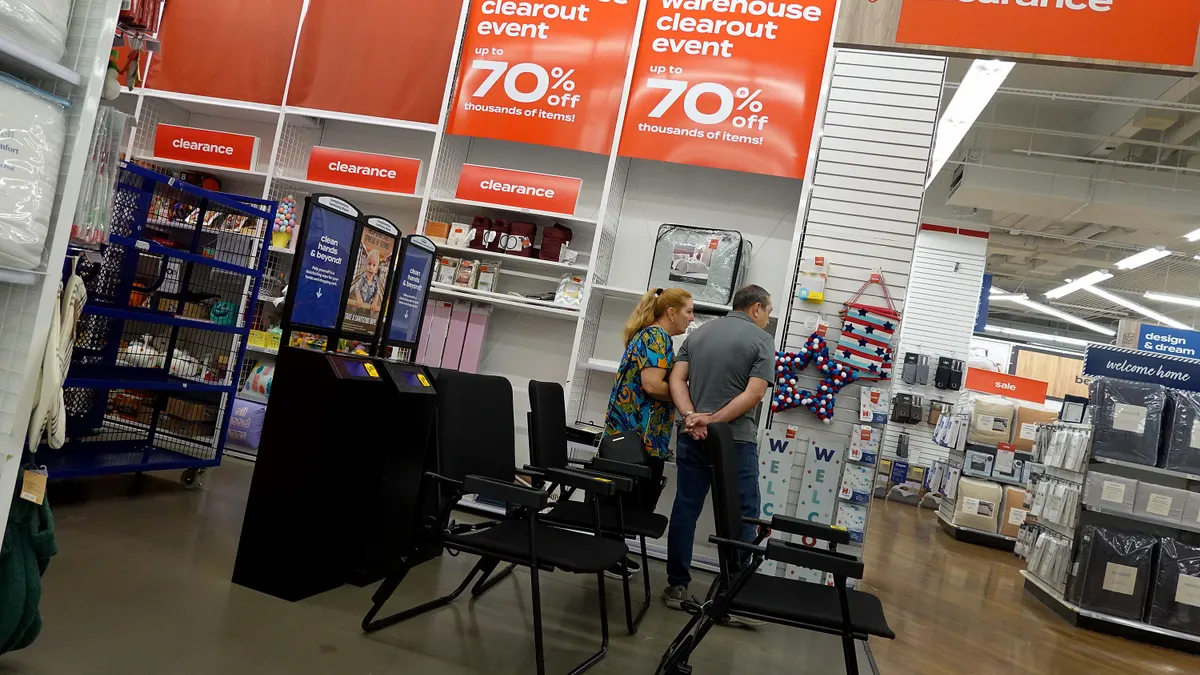Home-goods retailer Bed Bath & Beyond is sending mixed signals by filing a Chapter 11 bankruptcy over the weekend while simultaneously moving to close its 475 remaining brick and mortar stores, analysts say.
Under Chapter 11 of the U.S. Bankruptcy Code that Bed Bath & Beyond chose, companies seek to stay in business by working with creditors to restructure their debt. In contrast, a filing under Chapter 7 of the code is a liquidation for scenarios where profitability isn’t a possibility and in such cases the company’s operations are terminated and a trustee takes control “to ensure creditors benefit from the maximum value of the debtor’s assets,” according to Cornell Law School’s Legal Information Institute.
The storied Union, New Jersey-based company’s next steps seem to be straddling the two bankruptcy scenarios but that’s not altogether unusual, according to analysts. In 2017, Toys “R” Us, another high profile Garden State-based retailer, filed for Chapter 11, aiming to restructure its debt and keep operating only to announce about six months later that it would wind down its U.S. operations, as previously reported by Industry Dive sister publication Retail Dive.
Most businesses file for Chapter 11 and try to keep operations going in some form in order to keep some money and customers coming in the door, according to Rick Watson, CEO and founder of RMW Commerce Consulting, a retail and e-commerce consulting firm based in New York City. That’s why Watson, who didn’t rule out the possibility of the company ending up in liquidation, was a little confused to hear Bed Bath & Beyond was already moving to close stores.
Still, he maintains that there’s “better than even odds” that Bed Bath & Beyond will restructure in Chapter 11 or at least be able to sell some of its assets such as its real estate, technology and brand names at a market price rather than move to a liquidation situation in which assets will fetch lower values. Chapter 7 is a much more drastic and less attractive option for companies, he said.
“As soon as you file Chapter 7 everything stops,” Watson said in an interview, noting that the trustee steps in and takes the control from management and vendors typically have a much harder time getting paid. “Once you shut it down then everyone goes home and it’s very hard to get it running again.”
A transitory state
Most analysts agree the jury is still out on the fate of the company even as the situation appears dire.
Jaime M. Katz, a Morningstar senior equity analyst who has followed the long-struggling Bed Bath & Beyond and its many last-ditch attempts to buy time to find investors, noted she suspected that the Chapter 11 could be a “transitory state” for the retailer. It may be following a route trod previously by Toys “R” Us, which took about six months before it converted to a Chapter 7.
“I suspect that Chapter 11 buys them time to find a buyer for buybuy BABY — although I think if there was a buyer interested we would have heard something by now. They’ve been looking at strategic alternatives for a while to stay afloat,” Katz wrote in an emailed response to questions from CFO Dive. Bed Bath & Beyond’s buybuy BABY stores sell everything from strollers to furniture and clothing for babies.
Morningstar, which slashed its fair value of the company’s shares to $0 on Jan. 5 after the retailer warned that there was “substantial doubt about the company’s ability to continue as a going concern,” dropped its coverage of the retailer on Sunday after the filing. Morningstar analysts led by Katz Sunday wrote that even with a fresh $240 million in debtor-in-possession financing and plans to pursue sales of its “nameplates,” cash proceeds from sales would be used to satisfy remaining obligations of the business, “leaving any equity position worthless.”
Separately, James Gellert, CEO of Rapid Ratings, writing in an email sent to CFO Dive, was still hopeful about Bed Bath & Beyond’s prospects noting that it remains to be seen if there’s a buyer for the buybuy Baby asset and calling the situation fluid. “Management has been highly creative in trying to save this business and are likely working every imaginable angle, including selling assets. If the company has determined there isn't a viable path forward for the core Bed Bath & Beyond asset, liquidating may generate the most cash in the shortest term,” he wrote.
The long shot
In a Sunday bankruptcy court filing, Holly Etlin, who stepped into the roles of CFO and chief restructuring officer Saturday after becoming Bed Bath & Beyond’s interim CFO in February, described a company whose finances are under great pressure even as she asserted it should not yet be counted out of commission.
“While the commencement of a full chain wind-down is necessitated by economic realities, Bed Bath & Beyond has and will continue to market their businesses as a going-concern, including the buybuy Baby business. Bed Bath & Beyond has pulled off long shot transactions several times in the last six months, so nobody should think Bed Bath & Beyond will not be able to do so again,” Etlin’s filing states. At the same time, the filing also states that the company plans to complete all closing sales and wind down all 475 remaining brick-and-mortar stores by June 30, reaping approximately $718 million in net sales proceeds.
Nasdaq has alerted the retailer that trading in its shares would be suspended May 3. The stock has slumped to trade at just over $0.10 a share Thursday, well-below its 52-week high of $30.
Bed Bath & Beyond did not respond to requests for comment.




















